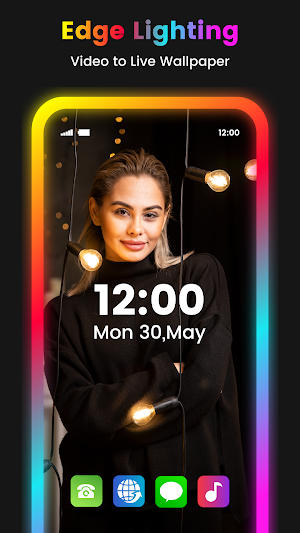



Enhance your screen with vibrant of Edge Lighting stylish LED effects




Edge Lighting, as a concept, emerged as a response to the growing demand for unique and immersive visual experiences. It all started with the development of LED (Light Emitting Diode) technology. LEDs offered a more efficient and versatile way of producing light compared to traditional incandescent bulbs. Their compact size and lower power consumption made them ideal for integration into various electronic devices.
As Ambilight gained popularity in the television industry, other manufacturers began to explore similar technologies. Samsung introduced its version called "Samsung Edge Lighting," primarily for its smartphones. Meanwhile, LG brought its "Edge-Lit LED" technology to computer monitors and TVs.
The evolution of Edge Lighting has been closely tied to advancements in LED technology. LED technology has improved in terms of color accuracy, brightness, and efficiency. As LEDs became smaller and more affordable, they could be integrated into a wider range of devices, from smartphones to laptops and even home decor items.
One significant breakthrough was the development of RGB LEDs, which are capable of producing a wide spectrum of colors. This innovation allowed for more precise and customizable Edge Lighting effects, enabling users to match their lighting to their mood, décor, or even the content they were viewing on their screens.
In the era of smart devices, Edge Lighting has become a staple feature, particularly in smartphones and tablets. This integration serves both functional and aesthetic purposes. Not only does Edge Lighting enhance the overall look of a device, but it also provides essential notifications and alerts in a visually engaging manner.
The adoption of OLED (Organic Light Emitting Diode) displays in smartphones has further facilitated the integration of Edge Lighting. OLED screens can selectively illuminate individual pixels, allowing Edge Lighting to be more precise and energy-efficient. The curvature of OLED screens in some smartphones also complements the Edge Lighting concept, creating a seamless transition from the display to the edge lighting effects.
To understand Edge Lighting, it's essential to grasp the science of LED technology. LEDs are semiconductor devices that emit light when an electrical current passes through them. Unlike traditional incandescent bulbs, which produce light through the heating of a filament, LEDs emit light by electroluminescence, making them more energy-efficient and durable.
Edge Lighting relies on LEDs placed along the edges of a surface. These LEDs emit light, which is then evenly diffused across the surface to create a soft and ambient glow. The color and intensity of the light can be controlled by adjusting the current passing through the LEDs.
One of the key aspects of Edge Lighting is the ability to generate a wide range of colors. This is achieved by using RGB LEDs, which are capable of producing red, green, and blue light in various intensities. By mixing these primary colors, virtually any color in the visible spectrum can be created.
Users can choose their desired colors for Edge Lighting effects, allowing for personalization and synchronization with the device's theme or surroundings. The science behind this color mixing is based on additive color theory, where different colors of light are combined to create new colors. This principle is fundamental to the versatility of Edge Lighting.
The even distribution of light is crucial in creating the appealing and gentle glow associated with Edge Lighting. This is achieved through a process called light diffusion. In Edge Lighting, a diffusion layer or material is used to scatter the light emitted by the LEDs.
Edge Lighting goes beyond aesthetics; it serves a practical function by providing notifications and alerts in a visually engaging way. When a smartphone or tablet receives a call, text message, or app
EDGE lighting application use for all Android Devices. This edge light application...
Align your dish with an accurate angle! with the help of satellite...
Phone clone lets users conveniently transfer data between devices and share their...
All Language Translator use for all android Devices. Language Translator – Speak...
Frequently Asked Questions(FAQ)
Created with AppPage.net
Similar Apps - visible in preview.